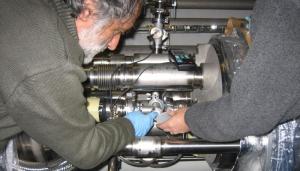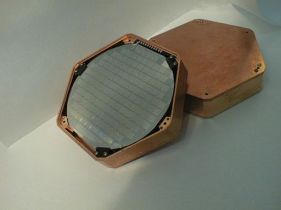Physicists at CERN have sent a ping-pong ball around the Large Hadron Collider in order to test for defects. However, this is no ordinary ping-pong ball, it is ultra-clean, smaller than regulation size and fitted with a radio transmitter. This so called radio-frequency ball was used to test that the connections between the magnets are free from any defects.
News
Researchers at the Super Cryogenic Dark Matter Search (CDMS) facility have recently uploaded a paper in which they announce that they have found three events that lie in the signal range of a Weakly Interacting Massive Particle (WIMPs). Continue Reading
 This morning physicists at CERN have finally announced that they have found a new boson with a significance of 5.0 sigma which is required to claim a discovery. Both the CMS and ATLAS detectors agree with the finding of a new boson with a mass of around 125.5 GeV and is consistent with the standard model. However, this is just the beginning, much more data is needed to find out more about its properties.
This morning physicists at CERN have finally announced that they have found a new boson with a significance of 5.0 sigma which is required to claim a discovery. Both the CMS and ATLAS detectors agree with the finding of a new boson with a mass of around 125.5 GeV and is consistent with the standard model. However, this is just the beginning, much more data is needed to find out more about its properties.
Due to this new discovery CERN has now decided to delay the LHC’s planned two year shutdown by 3 months. The planned shutdown aims to upgrade the LHC so it can reach 14 TeV.
So the Higgs has finally been found however, there is still no sign of supersymetry, which was tipped to be discovered before the Higgs.
Find out more on CERN’s homepage: http://public.web.cern.ch/public/
Also catch the live press conference here: http://webcast.web.cern.ch/webcast/
 Tomorrow morning , in a packed auditorium in CERN, the physicists will be revealing the latest update on the hunt for the Higgs boson, sometimes referred to as the ‘god’ particle. This could be the most anticipated moment in the history of modern science. The Higgs is the last particle of the standard model yet to be found, without it the standard model, the most successful theory in particle physics, falls apart. The idea of the Higgs boson was first introduced around 50 years ago to shore up the holes in the standard model and solve the long-standing mystery of why particles have mass and why some have more than others.
Tomorrow morning , in a packed auditorium in CERN, the physicists will be revealing the latest update on the hunt for the Higgs boson, sometimes referred to as the ‘god’ particle. This could be the most anticipated moment in the history of modern science. The Higgs is the last particle of the standard model yet to be found, without it the standard model, the most successful theory in particle physics, falls apart. The idea of the Higgs boson was first introduced around 50 years ago to shore up the holes in the standard model and solve the long-standing mystery of why particles have mass and why some have more than others.

Deep in the south of France the foundations are being layed for a machine that will hold an artificial star here on earth and harness its energy. It is called ITER and it is an experimental reactor that aims to prove that fusion is a commercially viable option for solving the world’s energy crisis. Fusion is set to revolutionise the world we live in with sustainable, green and safe energy.



